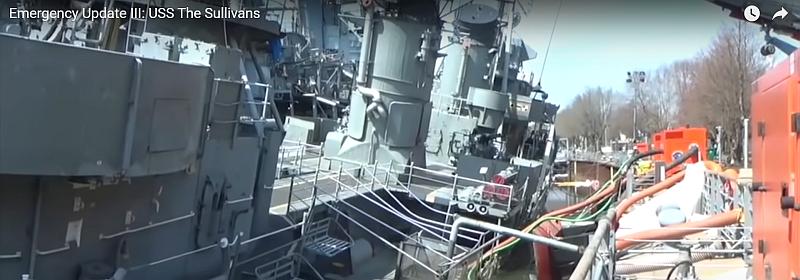 The museum ship, the retired United States Navy Fletcher-class destroyer USS The Sullivans, partially sank after taking on water at its berth in the Buffalo and Erie County Naval & Military Park, in mid-April. Now that the historic ship has been refloated, an assessment of the damage from the casualty has been underway. There is both good and bad news.
The museum ship, the retired United States Navy Fletcher-class destroyer USS The Sullivans, partially sank after taking on water at its berth in the Buffalo and Erie County Naval & Military Park, in mid-April. Now that the historic ship has been refloated, an assessment of the damage from the casualty has been underway. There is both good and bad news.
The good news is that many of the historic artifacts aboard the ship at the time of the flooding were either undamaged or may be salvageable. 5,000 folders of ship blueprints survived untouched while many documents stored in the ship’s office were submerged and all but ruined. An attempt will be made to freeze many of the papers in an attempt to preserve them.
It isn’t just water putting artifacts in danger. Oily waste and debris had filled many compartments of The Sullivans. Humidity and fumes were other potential troublemakers.
“Our role will be to preserve artifacts on board to tell the story of the ship,” Shane Stephenson, the Buffalo and Erie County Naval & Military Park’s director of museum collections, said, “and retell the story of the ship in new ways after she reopens again to visitors.”
Military.com reports that the bad news is that serious concerns remain over the rooms that took the brunt of the damage: the engineering room and ship office, which were an estimated 70% submerged, as well as berthing (sleeping) areas and the mess deck (or community space), which were about 50% submerged.
In his first assessment below deck, Stephenson called the damage to the ship’s interior “considerable,” but he remained optimistic that restoring the museum ship, a star of the naval park’s tours, would be key to its “living history.”
While the naval park is tentatively expected to reopen Memorial Day weekend, The Sullivans will likely be closed to the public for much longer as a new chapter unfolds in the ship’s 80-year history.
USS The Sullivans (DD-537) was named in honor of the five Sullivan brothers (George, Francis, Joseph, Madison, and Albert) aged 20 to 27 who lost their lives when their ship, USS Juneau, was sunk by a Japanese submarine during the Naval Battle of Guadalcanal on November 13, 1942. This was the greatest military loss by any one American family during World War II. She was also the first ship commissioned in the Navy that honored more than one person.
Thanks to Robert Kennedy for contributing to this post.

I guess the initial financial obstacles are tremendous and probably insurmountable, but in the long term surely it’s better to get these ships out of the water. Otherwise preservation is a losing game, and surely ultimately much more expensive.
Perhaps the first objective of any museum ship enterprise should be “where on land can we park this artifact?”
Leaving aside that a boat without the live feel of water under her keel feels a bit dead.